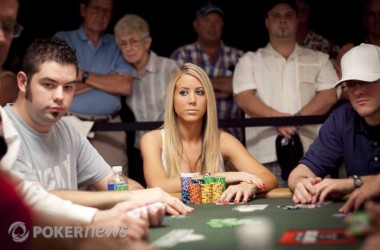Poker Book Review: 'Winning Poker Tournaments, Vol. 1' by Eric Lynch, Jon Van Fleet, and Jon Turner

This new collaboration, Winning Poker Tournaments: One Hand at a Time, Volume 1, marks a notable contribution to strategy discussions of no-limit hold'em tournament play, combining a host of useful ideas and concepts that have informed the trio of authors' tourney successes over recent years. Collectively, the book's three authors have nearly $1.5 million in live tournament winnings between them, plus numerous big online scores, the latter indicated by the fact that all three are additionally identified here by their well-known online monikers: Eric "Rizen" Lynch, Jon "Apestyles" Van Fleet, and Jon "PearlJammer" Turner.
As Matthew Hilger explains in the foreward, the book is patterned after Jim Brier and Bob Ciaffone's Middle Limit Hold'em, a book with which Winning Poker Tournaments indeed shares at least a couple of affinities. Like Middle Limit Hold'em, a book which features over 400 sample hands presented as problems allowing the authors to explore a host of theories and concepts, Winning Poker Tournaments also focuses entirely on hand discussions, with the three authors collectively presenting 194 hands. Another affinity the book shares with Middle Limit Hold'em is its intended audience, namely, experienced poker players already familiar with basic fundamentals and terminology who also possess an understanding of several concepts central to no-limit hold'em tournament play.
With little introductory fanfare, the sample hands begin. Turner and Lynch discuss 50 hands each, both starting with hands from early levels and concluding with hands played near or on the cash bubble. Then Van Fleet presents 30 early- and middle-stage hands, followed by a 44-hand sequence from the cash bubble portion of a single tournament. The volume then concludes with the three authors each responding to 20 of Hilger's tourney hands. All of the hand discussions begin with the "Setup" describing the specific situation, relevant player reads, and the respective author's own current image, then proceed through to the completion of the hand. Throughout the book, all of the hand discussions are clearly written and neatly formatted, making what might seem an arduous text especially reader-friendly.
Turner's 50 hands begin with several examples of his having demonstrated caution during the early rounds of a tournament, being careful with overpairs and other trouble hands and generally avoiding building big pots aside from those times when he holds a monster. Turner's examples (mostly from online tournaments, with a few live tourney hands thrown in) primarily show him playing either premium or speculative hands from a variety of positions. As mentioned already, it is assumed throughout the reader understands basic concepts (e.g., showdown value, squeeze plays, board texture), although the book does include a glossary that defines certain frequently used terms. Toward the end of the section, Turner shows instances of exploiting others' timid play as the cash bubble approaches, all the while exhibiting a keen awareness of the balance between risk and reward.
A common theme throughout Turner's hands and the book as a whole is the importance of thinking through how a given hand likely looks from one's opponent's perspective, and Lynch's 50 hands also illustrate several examples of such second- and third-level thinking. Like Turner, Lynch routinely exercises prudence during the early rounds and when out of position, though in his examples often shows himself opening pots with a wider variety of hands. All of Lynch's hands come from online tourneys, and in fact he occasionally incorporates online-specific issues such as possible disconnects, misclicks, and timing tells into the discussions. One also gets a sense throughout Lynch's section of the significant benefits of careful note-taking, as several of his hands show him successfully exploiting his knowledge of his opponents' tendencies thanks to having kept track of previous hands played with them.
In Van Fleet's section, the reader encounters a bit more math as he often incorporates detailed calculations of equity into the discussions of his decision-making. As was the case with Turner and Lynch, most of Van Fleet's hands come from deep-stacked tournaments that tend to require more sophisticated play. Like Lynch, Van Fleet appears to focus exclusively on online play, and also like Lynch shows himself often sizing bets in ways that (as Lynch says) "graphically 'appear' much larger than they are" (i.e., betting 999 rather than 1,000). As do his co-authors, Van Fleet likewise places great emphasis on pot control, getting away from trouble spots, and avoiding putting oneself in situations that require difficult decisions.
In the 44-hand sequence (called "The Bubble Section") that concludes his part of the book, Van Fleet takes us through a selection of consecutive hands from a particular $1 million guaranteed online tournament, beginning at a point when the tourney was 15 eliminations away from the money and taking us up to the hand when the bubble burst. The sequence goes quite well for Van Fleet, who begins with a big stack and ends among the chip leaders. As often happens at this stage of the tourney, the great majority of the hands end before the flop, thereby demonstrating in a dramatic way the importance of chips and position.
The book concludes with the three authors separately commenting on tourney hands submitted to them by Hilger, with each having made his comments without knowledge of what the others have said. Even though the trio are often on the same page with their advice, certain stylistic differences between them does emerge here, thus providing some interesting "dialogue" regarding the different ways one can assess similar information at the tables.
A second volume is planned for 2009, and one assumes that book will focus more specifically on play after the cash bubble has burst, final-table play, and heads-up. For now, serious tournament players can benefit greatly from this very instructive, smartly organized, well-written collection of hand discussions.









